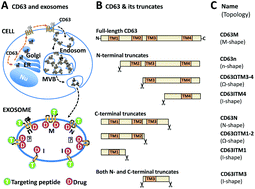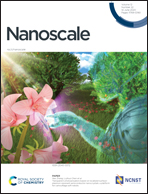Sequential deletion of CD63 identifies topologically distinct scaffolds for surface engineering of exosomes in living human cells†
Abstract
Exosomes are cell-derived extracellular vesicles that have great potential in the field of nano-medicine. However, a fundamental challenge in the engineering of exosomes is the design of biocompatible molecular scaffolds on their surface to enable cell targeting and therapeutic functions. CD63 is a hallmark protein of natural exosomes that is highly enriched on the external surface of the membrane. We have previously described engineering of CD63 for use as a molecular scaffold in order to introduce cell-targeting features to the exosome surface. Despite this initial success, the restrictive M-shaped topology of full-length CD63 may hinder specific applications that require N- or C-terminal display of cell-targeting moieties on the outer surface of the exosome. In this study, we describe new and topologically distinct CD63 scaffolds that enable robust and flexible surface engineering of exosomes. In particular, we conducted sequential deletions of the transmembrane helix of CD63 to generate a series of CD63 truncates, each genetically-fused to a fluorescent protein. Molecular and cellular characterization studies showed truncates of CD63 harboring the transmembrane helix 3 (TM3) correctly targeted and anchored to the exosome membrane and exhibited distinct n-, N-, Ω-, or I-shaped membrane topologies in the exosomal membrane. We further established that these truncates retained robust membrane-anchoring and exosome-targeting activities when stably expressed in the HEK293 cells. Moreover, HEK293 cells produced engineered exosomes in similar quantities to cells expressing full-length CD63. Based on the results of our systematic sequential deletion studies, we propose a model to understand molecular mechanisms that underlie membrane-anchoring and exosome targeting features of CD63. In summary, we have established new and topologically distinct scaffolds based on engineering of CD63 that enables flexible engineering of the exosome surface for applications in disease-targeted drug delivery and therapy.



 Please wait while we load your content...
Please wait while we load your content...